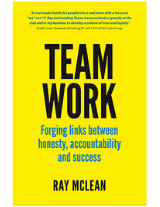This article was first published in the May 2016 edition of Human Resources Director.
It’s the goal of just about every leader, but unfortunately simply naming a group of people a team does not cut it – let alone when your objective is to create a high-performing executive team.
IN EVERY organisation, you will find that work functions require teams. We have sales teams, marketing teams, IT teams – the list goes on. The leaders at the top are usually referred to as the executive or leadership team.
Should we consider them a team just because they work together?
On the surface level, perhaps. They may have shared objectives, such as market dominance and profit margin. When these KPIs are met does that mean we have a high-performing team in the room, or even a team to begin with?
While being on target for bottom-line business results gives reason to believe everyone is working well towards a common goal, the reality can be very different. Key executives typically lead a particular function within the company and therefore might not have the same views on the strategic purpose of the firm as the next member of the team.
In our experience, high-performing teams at any level share three common traits: high expectations, high accountability and high-demand leadership. Most functional executive teams demonstrate facets of these traits. High expectations translate to having a clear understanding of individual roles and responsibilities, as well as living up to the culture and expected behaviours within the company. High accountability occurs when everyone is and can be held to account for individual performance and conduct.
High-demand leadership is recognised as leaders stepping up to the challenge, initiating genuine conversations and a healthy demand that people meet expectations. It is only when these qualities are manifested at an outstanding level that the executive team become role models for the expected behaviours within the organisation.
Diagnosis is the first step
Executive teams should begin with self-reflection and review collective and individual performance as an initial health check. We encourage teams we work with to agree and define their collective purpose (why do we exist as a team?), their team ‘trademark’ (how do we want to be described as a team?) and agreed behaviours (how should we behave to achieve our trademark?). A clear mandate on a shared purpose and interdependencies will prompt teamwork. Accepting differences and diversity is encouraged and should not hinder the process. It is crucial that every member knows what the team stands for and is aligned in terms of their framework and code of conduct.
When guiding principles are set the team is then able to make decisions and choices based on their understanding of both expected individual and group behaviour. With a coordinated and structured action plan, alongside metrics to determine buy-in, progress can be measured and evaluated over a period of time and an environment for genuine conversations is created. Recognition of the framework against which the team will be measured allows for high levels of accountability.
Secret to high performance
One of the key differences we notice between high-performing and lesser teams is the presence of strong professional relationships. This goes beyond footy talk or Friday evening drinks. A strong professional relationship translates to knowing your work environment is safe enough to allow sincere conversations and dialogue. We see this as the ability to provide ongoing support to colleagues, to offer feedback, and to challenge poor behaviour and reward positive outcomes with the desire for both executive-level and individual improvement.
Strong professional relationships lead to a higher tendency to collaborate, share information and come together to fi nd ways to overcome setbacks. They allow teams to address individual or shared challenges and display empathy, developing a mature understanding of colleagues. As a leader, a higher level of awareness and a commitment to seeking resolutions will also propel your team towards high performance.
Carrying it with candour
Voicing professional opinions sounds extremely straightforward, but we often find when we start working with an organisation that the office culture is in fact not a safe environment for open and honest professional dialogue. Often, people are engaged only in self-centred monologues: voicing opinions with no consideration for others and no interest in solutions or compromise. Either that, or they choose to vent and complain outside office walls. This lack of resolve to problem-solving is counter-productive to high performance.
When trust is built, healthy conflict – conflict with a commitment to action and resolution – is accepted, expected and embraced. For the executive team, where decision-making can involve higher risks or uncertainty, productive conflict and debate underpinned by strong professional relationships and using the agreed behaviours as a reference point can reveal more possibilities and lead to better outcomes for the team, the individual and the organisation.
High performance elements
In today’s business environment, a high-performing team is more important than ever to shape business performance. Dealing with ever-changing customer demands, disruptive digital technology and economic uncertainty, an organisation requires a nimble and flexible executive team comprised of complementary skill-sets and personalities to jointly solve and overcome business challenges.
Diagnosing the underlying reasons for under performance or wanting to bring the team to the next level requires a systematic approach to evaluate what is hindering and supports team performance.
To drive impactful change, there is a need to ensure that the team’s mandate, processes and culture are aligned. No one factor is the sole reason for dysfunction.
Recognising the factors that shape team performance, including influences within the organisation and the broader business landscape, will help leaders make adjustments and constantly fine tune their management approach to maintain a high-performing team.
HIGH PERFORMANCE HURDLES
What do you need to watch out for when attempting to create a high-performing team?
- Leaders who don’t believe in the value of instituting cultural change – and the investment required to achieve it.
- Leaders who fear that added rigour and accountability will expose them to scrutiny of their own performance.
- The team has a deep-seated lack of self-belief that they can become high performing.
- Leaders are unwilling or unable to exit team members that don’t meet cultural expectations.
- The team fails to own the new direction and doesn’t self-regulate their agreed behaviours.
- Leaders don’t believe in the value of instituting cultural change – and the investment required to achieve it.
Justin joined Leading Teams in 1996 as an athlete facilitator. After 17 years of a professional AFL career, playing 252 games, Justin became a full-time Facilitator/Partner in 2007.
Learn more about Justin.



